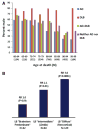Association between male gender and cortical Lewy body pathology in large autopsy series
- PMID: 20563821
- PMCID: PMC3040648
- DOI: 10.1007/s00415-010-5630-4
Association between male gender and cortical Lewy body pathology in large autopsy series
Abstract
Sex-linked factors may alter risk for neurodegenerative diseases. Definitive diagnoses are not established until autopsy, so neuropathological studies are critical. There have not been reported gender-related differences in neocortical Lewy bodies (LBs) using large multi-center autopsy series. We evaluated the associations between gender and pathologically characterized neurodegenerative diseases. Cases with Alzheimer's disease (AD), neocortical LBs, AD + neocortical LBs, or neither pathology were evaluated as separate groups. Results were corrected for possible confounders including age at death, smoking history, and education. The settings were the University of Kentucky Alzheimer's Disease Center and the National Alzheimer's Coordinating Center (NACC) Registry autopsy series; 3,830 subjects met inclusion criteria. Patients with neocortical ("diffuse") or intermediate ("limbic") LB pathologies tended to be male (male:female odds ratios ~2.9 with 95% CI 2.02-4.18). The preponderance of males dying with neocortical LB pathology was seen consistently across age groups and was not due to the potential confounders evaluated. By contrast, individuals dying with AD pathology were more likely to be female if dying over 80 (male:female odds ratio 0.66, 95% CI 0.50-0.88), but that tendency was not seen in individuals dying with AD pathology prior to age 80. Increased understanding of the male predominance in neocortical LB pathology may help guide clinicians, because males are more likely to be "undercalled" for neocortical LBs clinically, and females are more likely to be "overcalled" (P < 0.05 for both). Males are far more likely than females to die with neocortical LB pathology. This phenomenon may help guide medical practice including clinical trial study design.
Figures


References
-
- Consensus recommendations for the postmortem diagnosis of Alzheimer's disease The National Institute on aging, and Reagan Institute Working Group on diagnostic criteria for the neuropathological assessment of Alzheimer's disease. Neurobiol Aging. 1997;18(4):S1–S2. - PubMed
-
- Andersen K, Launer LJ, Dewey ME, Letenneur L, Ott A, Copeland JR, Dartigues JF, Kragh-Sorensen P, Baldereschi M, Brayne C, Lobo A, Martinez-Lage JM, Stijnen T, Hofman A. Gender differences in the incidence of AD and vascular dementia: the EURODEM studies. EURODEM Incidence Research Group. Neurology. 1999;53:1992–1997. - PubMed
-
- Barker WW, Luis CA, Kashuba A, Luis M, Harwood DG, Loewenstein D, Waters C, Jimison P, Shepherd E, Sevush S, Graff-Radford N, Newland D, Todd M, Miller B, Gold M, Heilman K, Doty L, Goodman I, Robinson B, Pearl G, Dickson D, Duara R. Relative frequencies of Alzheimer disease, Lewy body, vascular and frontotemporal dementia, and hippocampal sclerosis in the State of Florida Brain Bank. Alzheimer Dis Assoc Disord. 2002;16:203–212. - PubMed
-
- Barrett AM. Probable Alzheimer's disease: gender-related issues. J Gend Specif Med. 1999;2:55–60. - PubMed
-
- Beekly DL, Ramos EM, van Belle G, Deitrich W, Clark AD, Jacka ME, Kukull WA. The National Alzheimer's Coordinating Center (NACC) Database: an Alzheimer disease database. Alzheimer Dis Assoc Disord. 2004;18:270–277. - PubMed
Publication types
MeSH terms
Grants and funding
LinkOut - more resources
Full Text Sources
Medical
Miscellaneous

